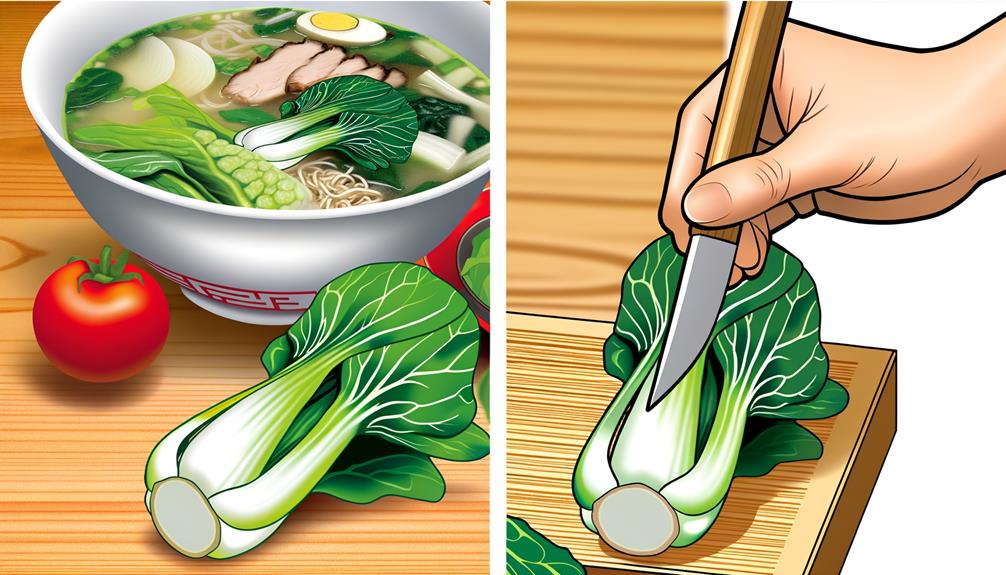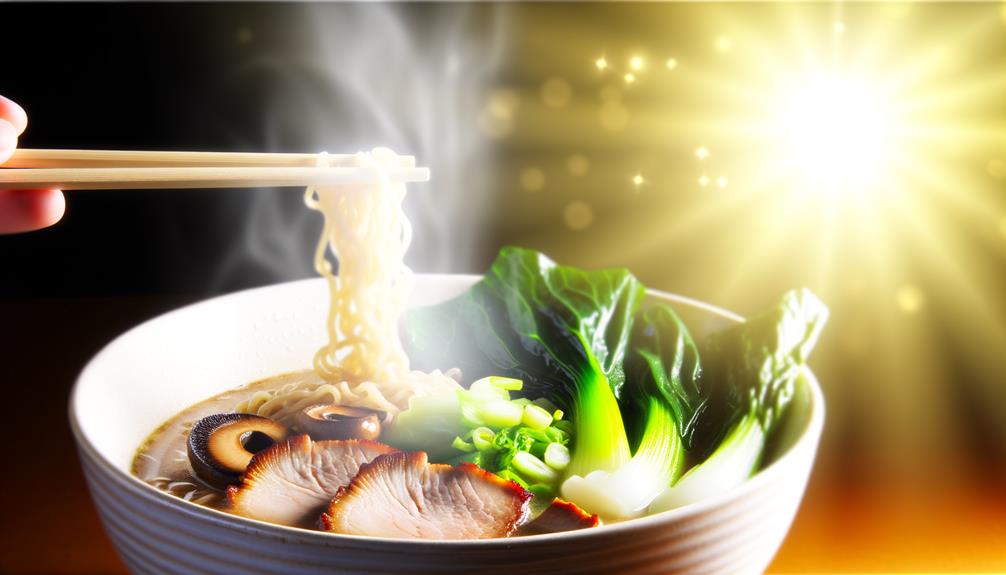To cook bok choy for ramen, pick it fresh with crisp leaves and firm stems. Give it a good clean and trim off any brown bits. Blanch it in boiling salted water, then shock it in ice water to preserve its color and crunch. Alternatively, stir-fry it with a little garlic and ginger for a flavor twist. Add your prepared bok choy to your ramen broth and let it simmer until it has absorbed the tasty flavors. Put together your noodles, bok choy and broth, and your ramen is ready to go. Stick around, and you'll uncover even more secrets to perfecting this dish.
Bok Choy's Culinary Origins
Let's delve into the culinary origins of bok choy, a type of Chinese cabbage that has become an essential ingredient in Asian cuisine, particularly in dishes like ramen. Bok choy's story begins in China, where it has been cultivated for over 5,000 years. It's valued for its crunchy texture and slightly sweet flavor. Over time, this leafy green vegetable has found its way into the kitchens of many Asian countries, imparting its unique taste to a variety of dishes.
When it comes to ramen, bok choy's role is vital. It's often blanched or stir-fried before being added to the flavorful broth. Sometimes, I simply add it directly for a tender yet crispy addition. The gentle flavor of bok choy complements the rich, umami-filled depth of ramen broth, typically prepared with garlic, soy sauce, shiitake mushrooms, and miso paste.
Cooking bok choy for ramen isn't complex. After a quick rinse, I usually cut it in half or quarters. Then, I prepare it using my preferred method and sprinkle some sesame seeds on top. The outcome is a nutritious, flavorful element that enhances my bowl of noodles to new heights.
Essential Bok Choy Soup Components
When it comes to enhancing your homemade ramen with bok choy, there are several key elements to consider. The first is the selection of the bok choy. It's important to choose fresh bok choy with vibrant green leaves and firm stems. This not only guarantees the best taste, but it also maximizes the nutritious value of your dish.
Next, you'll need to decide how to cook your bok choy. I love to blanch or stir-fry it for a tender yet crunchy texture. If you're stir-frying, don't forget to toss in some garlic and ginger for an extra flavor boost.
Finally, adding the bok choy to your ramen soup. Make sure that your water is boiling before you add your bok choy and ramen noodles. This will allow the bok choy to cook evenly and absorb the flavors of your soup.
Here's a quick overview of these essentials:
| Ramen Component | Tips |
|---|---|
| Bok Choy Selection | Choose fresh, vibrant green leaves with firm stems |
| Cooking Method | Blanch or stir-fry with garlic and ginger |
| Adding to Soup | Add to boiling water and stir in ramen noodles |
With these tips, you're ready to elevate your ramen to the next level with bok choy.
Bok Choy Ramen Preparation

Preparing bok choy ramen involves a few simple steps, starting with trimming and cleaning the baby bok choy leaves. It's as simple as snipping off any brown bits and giving the leaves a good rinse under cold water.
Next, it's time to deal with the ramen broth. This is where things get a little more exciting. The broth is where all the flavor lives, so it's important to get it right.
- Start by incorporating miso paste and smoked shoyu into the broth. The miso paste adds a rich, savory flavor while the smoked shoyu gives it that classic, umami-rich taste that's so integral to a good bowl of ramen.
- Next, add a little punch with some red pepper flakes.
- Finally, drop your cleaned bok choy leaves into the simmering broth. Stir gently to make certain that all the leaves are well submerged and let them cook for a few minutes.
Meanwhile, prepare your noodles. I'm partial to Forbidden Rice Ramen Noodles. They're gluten-free and have a unique, nutty flavor that pairs beautifully with the bok choy and the savory broth. Once everything's ready, simply combine and enjoy your bok choy ramen!
Expert Tips
Now let's move on to some expert tips for cooking bok choy for your ramen.
We'll talk about:
- How to choose the best bok choy
- The right way to prepare it
- The best techniques for cooking
Trust me, these tips will make your bok choy the star of your ramen dish!
Choosing Quality Bok Choy
Picking the right baby bok choy is key to a flavorful ramen. Here are five expert tips to make sure you select the best:
- Look for vibrant, crisp leaves and firm stems – these are signs of fresh, quality bok choy.
- Check the leaves are unblemished and show no discoloration.
- Opt for a piece that feels heavy for its size. This heaviness suggests a high water content, which indicates freshness.
- Avoid any bok choy with wilted or yellowing leaves, as this can signal age or spoilage.
- Try to select organic bok choy if possible, to reduce your exposure to pesticides and other chemicals.
These tips should help you choose the best bok choy for your ramen.
Proper Preparation Steps
Often, the secret to a tantalizing bowl of ramen lies in how you handle the baby bok choy, so let's explore the expert steps for preparing it perfectly.
Begin by trimming and cleaning the bok choy, removing any dirt or discolored areas. An initial blanching step, involving a 1-2 minute dip in boiling salted water, is crucial to preserving the bok choy's color and crisp texture.
After blanching, quickly transfer it to ice water, which halts the cooking process, maintaining its vibrant hue and crunch. Alternatively, for a unique texture, stir-fry the bok choy with garlic and ginger.
The goal is to achieve a tender but still slightly crisp finish. These steps will guarantee your bok choy is primed to perfection, ready to enhance your ramen noodle soup.
Ideal Cooking Techniques
To truly master the art of cooking bok choy, let's explore some ideal techniques that can elevate your ramen to an entirely new level.
First, blanch the bok choy in boiling water for 1-2 minutes. This keeps its color vibrant and maintains its crunchiness. After this, drain and set it aside.
Then, heat some oil in a soup pot, add chopped garlic and ginger, and stir-fry until fragrant. This is where you introduce the bok choy back into the pot and cook until tender.
Final Thoughts
To conclude, incorporating baby bok choy into your ramen not only enhances the flavor but also boosts the nutritional value of your meal. This versatile vegetable is quick and simple to prepare, with various cooking methods available to bring out its best. The key is to select fresh, vibrant baby bok choy and cook it just right to make sure it maintains its tender texture and mild, slightly sweet flavor.
Blanching is one popular way to cook baby bok choy, as it helps preserve both the color and crunchiness of the stems. Alternatively, stir-frying with a little garlic and ginger can infuse the bok choy with exciting flavors that complement your ramen beautifully.
The cooking time is crucial, though. You don't want to overcook the bok choy, as it might lose its texture and flavor. Whether you're placing it on top of the noodles or simmering it directly in the broth, make sure it's cooked to your desired level of tenderness.
In the end, adding baby bok choy to your ramen is a simple step that can transform your regular noodle soup into a nutrient-rich, delicious meal. Enjoy your cooking journey!
